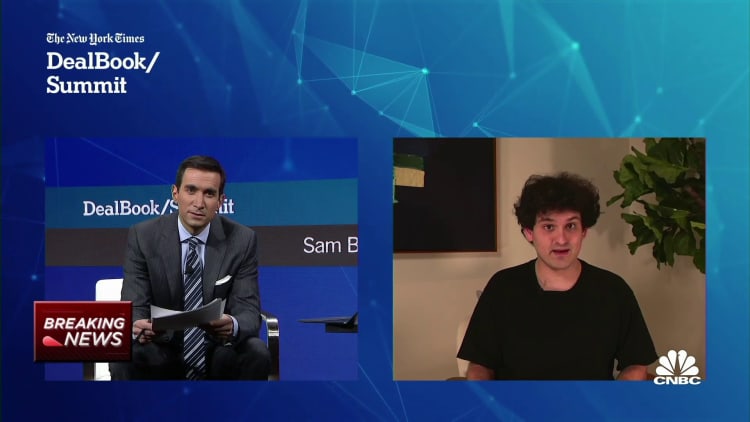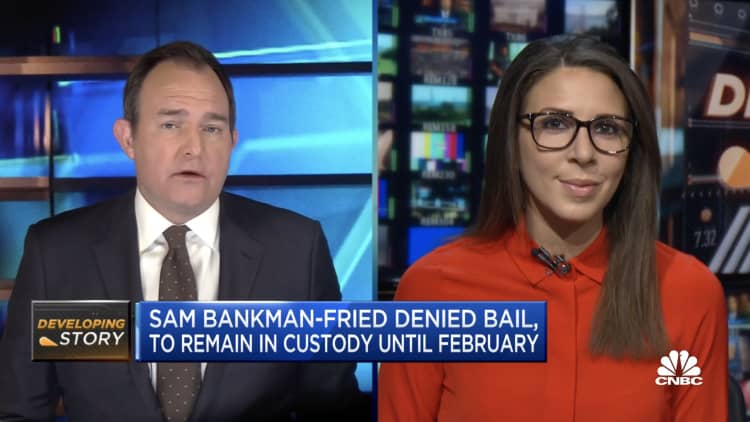
Before his surprise Monday night arrest, Sam Bankman-Fried had apologized for everything he could think of, to everyone who would listen. In a leaked draft of his aborted House testimony, he wrote that he was truly, for his entire adult life, “sad.” He “f—– up,” he tweeted, and wrote, and said.
He told Bahamas regulators he was “deeply sorry for ending up in this position.” But when Bankman-Fried was escorted out of his penthouse apartment in Nassau in handcuffs, it still wasn’t clear what he was apologizing for, having stridently denied committing fraud to CNBC’s Andrew Ross Sorkin, ABC News’ George Stephanopoulos, and across Twitter for weeks.
related investing news


But the day after his arrest, federal prosecutors and regulators unsealed dozens of pages of filings and charges that accused Bankman-Fried of not just having perpetrated a fraud, but having done so “from the start,” according to a filing from the Securities Exchange Commission
Far from having “f—– up,” SEC and Commodity Futures Trading Commission regulators, alongside federal prosecutors from the United States Attorney’s Office for the Southern District of New York, allege that Bankman-Fried was at the heart — indeed, the driver — of “one of the biggest financial frauds in American history,” in the words of U.S. Attorney Damian Williams. The allegations against Bankman-Fried were assembled with stunning speed, but offer insight into one of the highest-profile fraud prosecutions since Enron.
Bankman-Fried founded his crypto hedge fund Alameda Research in November 2017, renting office space in Berkeley, California. The scion of two Stanford law professors, Bankman-Fried had graduated from MIT, worked at the prestigious quantitative trading firm Jane Street Capital, and had broken into cryptocurrencies with a MIT classmate, Gary Wang.
Alameda Research was essentially an arbitrage shop, purchasing bitcoin at a lower price from one exchange and selling it for a higher price at another. Price differences in South Korea versus the rest of the world allowed Bankman-Fried and Wang to profit tremendously from what was nicknamed “the kimchi swap.”
In April 2019, Bankman-Fried and Wang — along with U.C. Berkeley graduate Nishad Singh — founded FTX.com, an international cryptocurrency exchange that offered customers innovative trading features, a responsive platform, and a reliable experience.
Federal regulators at the CFTC say that just a month after founding FTX.com, Bankman-Fried, “unbeknownst to all but a small circle of insiders,” was leveraging customer assets — specifically, customers’ personal cryptocurrency deposits — for Alameda’s own bets.
Rehypothecation is the term for when businesses legally use customer assets to speculate and invest. But Bankman-Fried didn’t have permission from customers to gamble with their funds. FTX’s own terms of use specifically forbade him, or Alameda, from using customer money for anything — unless the customer allowed it.
And from FTX’s inception, there was a lot of customer money. The CFTC cited 2019 reports from FTX which pegged the futures volume alone as often exceeding $100 million every day.
Using customer money for Alameda’s bets constituted fraud, the CFTC alleges. In the Southern District of New York, where Bankman-Fried was indicted by a grand jury, Bankman-Fried faces criminal fraud charges as well. From the very genesis of FTX, regulators allege, Bankman-Fried was using customer funds to bankroll his speculative investments.
It is a swift fall from grace for the one-time king of crypto, who as recently as two months ago was hailed as the savior of the industry. Now, Bankman-Fried heads to a Bahamian court on Monday to surrender himself to the U.S. extradition process, according to a person familiar with the matter. A criminal trial awaits him once he is back on U.S. soil.
Attorneys for Bankman-Fried, and attorneys for his former companies, did not immediately return requests for comment. A representative for Bankman-Fried declined to comment.

The rise of the Alameda-FTX empire
FTX quickly rose, launching its own token, FTT, in July 2019 and snagging an equity investment from Binance in November of that year.
By 2021, according to the CFTC filing, FTX and its subsidiaries held roughly $15 billion worth of assets, and accounted for 10% of global digital transaction volume, clearing $16 billion worth of customer trades every day.
The firm’s “years-long” fraud didn’t just extend to playing with customer money, according to the SEC.
FTX was able to operate so effectively, clear such massive volume, and generate such interest because it had a designated market maker (DMM) of its own. In traditional finance, a DMM is a firm that will buy and sell securities to and from customers, hoping to clear a profit in any difference in price, called the spread.
From FTX’s 2019 founding, Alameda was that market maker, snapping up and releasing cryptocurrencies on the exchange. Alameda and FTX’s symbiotic relationship proved advantageous for both ends of Bankman-Fried’s growing empire.
As FTX matured, other market makers came online to offer liquidity. But Alameda was, and remained, FTX’s largest liquidity provider, easing platform function at “Bankman-Fried’s direction,” the SEC alleges.
Unlike those other market makers or power users, Alameda had a set of powerful tools at its disposal.
In August 2019, the SEC alleges, Bankman-Fried directed his team at FTX to program an exception into the exchange’s code, allowing Alameda to “maintain a negative balance in its account, untethered from any collateral requirements.”
“No other customer account at FTX was permitted to maintain a negative balance,” the SEC filing continues. The negative balance meant that Alameda was allegedly effectively backstopped by customer assets while making trades.
Former Alameda CEO Caroline Ellison once alluded to this in a widely disseminated interview.
“We tend not to have things like stop losses,” Ellison said.
In traditional finance, a stop-loss order helps traders limit exposure to a potentially losing trade. When an asset (a stock, for example) reaches a pre-determined lower limit, the stop-loss order will automatically sell off the asset to prevent losses from spiraling out of control.
Not content with what would eventually become a “virtually unlimited” line of credit from investors — his own customers — Bankman-Fried conspired to stack the deck in Alameda’s favor, regulators say.
FTX offered power users access to an API — an interface that allowed the user to bypass FTX’s front-end platform and communicate directly with FTX’s back-end systems. Normal users were still subjected to common-sense checks: verifying that they had enough money in their account, for example.
Alameda traders could access a fast-lane which let them shunt past other users and shave “several milliseconds” off their trade execution times, according to the CFTC. The kind of high-frequency trading that FTX users engaged in made that invaluable.

A lousy crypto hedge fund
Despite the deck being stacked in Alameda’s favor, the hedge fund offered terrible returns. A court filing indicated that Alameda lost over $3.7 billion over its lifetime, despite public statements by FTX leaders touting how profitable the trading arm was.
Alameda’s losses and lending structure were a critical component of FTX’s eventual collapse.
Alameda didn’t just play fast and loose with customer money. The hedge fund borrowed aggressively from multiple lenders, including Voyager Digital and BlockFi Lending. Both those companies entered Chapter 11 bankruptcy proceedings this year, and FTX targeted both for acquisition.
Alameda secured its loans from Voyager and BlockFi with FTT tokens, which FTX minted itself. Bankman-Fried’s empire controlled the vast majority of the available currency, with only a small amount of FTT actually circulating at any time.
Alameda should have acknowledged the fact that its tokens couldn’t be sold at the price that they claimed they were worth, the CFTC alleges in its complaint.
This was because any attempt by Alameda to sell off their FTT tokens would crater FTT’s price, given how much of the available supply Alameda controlled.
Instead of correctly marking its tokens to market, though, Alameda recorded their entire hoard of FTT as being worth the prevailing market price.
Alameda used this methodology with other coins as well, including Solana and Serum (a token created and promoted by FTX and Alameda), using them to collateralize billions in loans to other crypto players. Industry insiders even had a nickname for those tokens — “Sam coins.”
The tables turned after the collapse of Luna, a stablecoin whose implosion and subsequent crash devastated other lenders and crypto firms and sent crypto prices plunging. Major Alameda lenders, like Voyager, declared bankruptcy. Remaining lenders began to execute margin calls or liquidate open positions with customers, including Alameda.
The CFTC alleges that between May and June 2022, Alameda was subjected to “a large number of margin calls and loan recalls.”
Unbeknownst to investors, lenders, or regulators, Alameda lacked enough liquid assets to service its loan obligations.
But while Alameda was illiquid, FTX’s customers — who had been constantly reassured that the exchange, and Bankman-Fried, were determined to protect their interests — were not.

The fraud — exposed
Bankman-Fried stepped down from his leadership position at Alameda Research in Oct. 2021 in what CFTC regulators claim was a calculated bid to cultivate a false sense of separation between FTX and the hedge fund. But he continued to exercise control, regulators claim.
Bankman-Fried allegedly ordered Alameda to increase its use of customer assets, drawing down massively on its “unlimited” credit line at FTX.
“Alameda was able to rely on its undisclosed ordinary-course access to FTX credit and customer funds to facilitate these large withdrawals, which were several billion dollars in notional value,” the CFTC filing reads.
By the middle of 2022, Alameda owed FTX’s unwitting customers approximately $8 billion. Bankman-Fried had testified before the House that FTX boasted world-class risk management and compliance systems, but in reality, according to the firm’s own bankruptcy filings, it possessed almost nothing in the way of record-keeping.
Then, on Nov. 2, the first domino fell. Crypto trade publication CoinDesk publicized details on Alameda’s balance sheet which showed $14.6 billion in assets. Over $7 billion of those assets were either FTT tokens or Bankman-Fried-backed coins like Solana or Serum. Another $2 billion were locked away in equity investments.
For the first time ever, the secretive inner workings of Alameda Research were revealed to be a modern-day Potemkin village. Investors began to liquidate their FTT tokens and withdraw their holdings from FTX, a potentially calamitous situation for Bankman-Fried.
Alameda still had billions of collateralized loans outstanding — but if the value of their collateral, FTT, fell too far, their lenders would execute further margin calls, demanding full repayment of loans.
Allegedly, Alameda had already been unable to fulfill loan obligations over the summer without accessing customer funds. Now, with money flowing out of the exchange and FTT’s price slipping, Alameda and FTX faced a liquidity crunch.
In a now-deleted tweet, Bankman-Fried continued to claim FTX was fully funded and that customer assets were safe. But on Nov. 6, four days after the CoinDesk article, the crack widened into a chasm, thanks to an old investor-turned-rival, Changpeng “CZ” Zhao.
Zhao founded Binance in 2017, and it was the first outside investor in FTX, funding a Series A round in 2019. It had exited the investment by July 2021, the same year that FTX raised $1 billion from big names like Sequoia Capital and Thoma Bravo.
FTX bought out Binance with a combination of BUSD, BNB, and FTT, according to Zhao.
BUSD is Binance’s exchange-issued stablecoin, pegged to the value of the U.S. dollar. BNB is their exchange token, similar to FTX’s FTT, issued by Binance and used to pay transaction and trading fees on the exchange.
Zhao dropped the hammer with a tweet saying that because of “recent revelations that have came [sic] to light, we have decided to liquidate any remaining FTT on our books.”
FTX executives scrambled to contain potential damage. Ellison responded to Zhao offering to purchase Binance’s remaining FTT position for $22 per token.
Privately, Bankman-Fried ordered Alameda traders to liquidate Alameda’s investments and positions “to rapidly free up capital for FTT buybacks,” the CFTC filing states. Bankman-Fried was preparing to bet the house in an effort to maintain Ellison’s public support level of $22.
Alameda traders managed to fend off outflows for two days, holding the price of FTT at around $22.
Publicly, Bankman-Fried continued to operate as if all was well. “FTX is fine. Assets are fine,” he wrote in a tweet on Nov. 7 that has since been deleted. Bankman-Fried asserted that FTX did not invest client assets and that all redemptions would be processed.
But at the same time Bankman-Fried was tweeting reassurances, internally, executives were growing more and more alarmed at the increasing shortfall, according to prosecutors. It was “not merely a matter of having sufficient liquid funds on hand to cover customer withdrawals,” the CFTC alleges.
Rather, Bankman-Fried and other executives admitted to each other that “FTX customer funds were irrevocably lost because Alameda had appropriated them.”
It was an admission that flew in the face of everything Bankman-Fried would claim publicly up through the day of his arrest, a month later.
By Nov. 8, the shortfall had grown from $1 billion to $8 billion. Bankman-Fried had been courting outside investors for a rescue package. “Numerous parties declined […] regardless of the favorable terms being offered,” the CFTC filing alleges.
FTX issued a pause on all customer withdrawals that day. FTT’s price plummeted by over 75%. Bankman-Fried was in the midst of a high-tech, decentralized run on the bank. Out of options, he turned to Zhao, who announced that he’d signed a “non-binding” letter of intent to acquire FTX.com.
But just a day later, on Nov. 9, Binance said it would not go through with the acquisition, citing reports of “mishandled customer funds” and federal investigations.
Two days later, Bankman-Fried resigned as CEO of FTX and associated entities. FTX’s longtime attorneys at Sullivan & Cromwell approached John J. Ray, who oversaw Enron through its bankruptcy, to assume Bankman-Fried’s former position.
FTX filed for bankruptcy that same day, on Nov. 11. A month later, Bankman-Fried was arrested by Bahamian authorities, pending extradition on charges of fraud, conspiracy, and money laundering.
Bankman-Fried, a devotee of a philosophy known as “effective altruism,” was apparently driven by an obsessive need to quantify the impact he had on this world, measured in dollars and tokens. He drafted a spreadsheet which measured the influence that Alameda had on the planet (and determined it was nearly a net wash).
Billions of dollars of customer money are now floating in venture funds, political war chests and charitable coffers — money now at risk of being clawed back, thanks to Bankman-Fried’s alleged crimes.
Almost a decade ago, Bankman-Fried posed a hypothetical question to his friends and family on his personal blog: Waxing poetic on effective altruism, he asked rhetorically, “Just how much impact can a dollar have?”
“Well, if you want a one-sentence answer, here it is: one two thousandth of a life,” he said.
The CFTC alleges that over $8 billion dollars of customer funds are missing. Some customers have doubtless lost their life savings, their kid’s college funds, their future down payments. By Bankman-Fried’s own math, his alleged misdeeds were worth four million lives.







